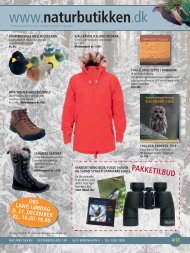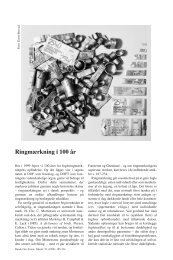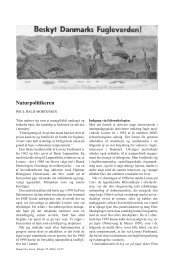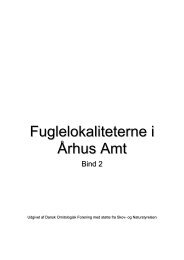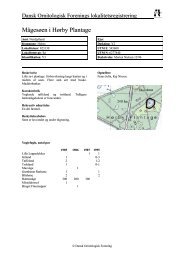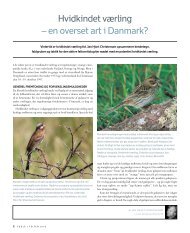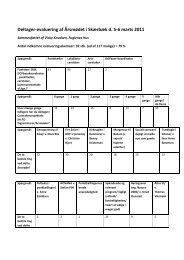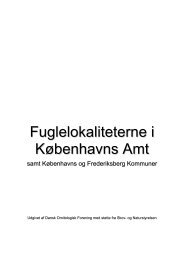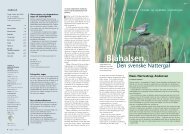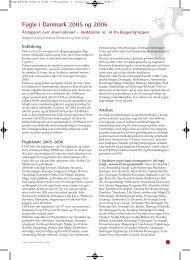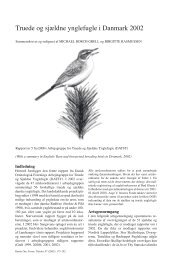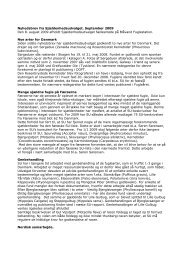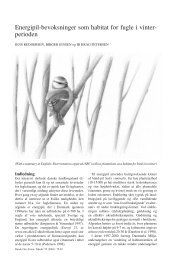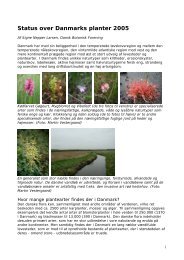Ynglefugle i Vejlerne - Dansk Ornitologisk Forening
Ynglefugle i Vejlerne - Dansk Ornitologisk Forening
Ynglefugle i Vejlerne - Dansk Ornitologisk Forening
Create successful ePaper yourself
Turn your PDF publications into a flip-book with our unique Google optimized e-Paper software.
population in <strong>Vejlerne</strong> a parallel development has been<br />
seen elsewhere throughout Denmark, and factors affecting<br />
this development are probably found outside<br />
<strong>Vejlerne</strong> and a common feature for the whole Danish<br />
popu la tion. <strong>Vejlerne</strong> held approx. 10% of that population<br />
around 1990, rather notable for a species that only<br />
estab lished itself in the area 10 years earlier, and far<br />
away from the main Danish breeding concentrations<br />
of Southeast Denmark. The national population around<br />
2000 is judged at 300-500 pairs, and <strong>Vejlerne</strong> must have<br />
been one of the most important sites for the species in<br />
Den mark, given the high population levels of <strong>Vejlerne</strong><br />
in 1999-2003. Although several pairs might attempt to<br />
breed, they appear to have a rather poor breeding success,<br />
because cases of conrmed breeding only represent<br />
4% of the mapped population (Table 19).<br />
Common Teal was a rather common breeder in <strong>Vejlerne</strong><br />
itself, and especially in the surroundings of <strong>Vejlerne</strong> in<br />
the 1930s, but since then the species has almost disappeared.<br />
The species breeds in nutrient poor wetlands,<br />
and the disappearance of the species is probably related<br />
to increased eutrophication of their former breeding habitat<br />
and its resulting overgrowth.<br />
Since 1984 the annual population has been estimated<br />
between zero and seven possible breeding pairs. Evaluation<br />
of the breeding population is however very dif-<br />
cult, because many birds spend the summer and moult<br />
in <strong>Vejlerne</strong>.<br />
Mallard is a common breeder in <strong>Vejlerne</strong>, in fact so numerous<br />
that a precise mapping of the population is considered<br />
impossible. The population development is thus<br />
estimated as a relative index, based on the number of<br />
observed pairs plus stationary males in a 15-20 days period<br />
of late April and early May each year since 1978,<br />
and since 1984 all broods have been recorded as well<br />
(Table 21). There is only a weak tendency of parallel developments<br />
in the index and the number of females attending<br />
broods, suggesting large variations in breeding<br />
success (Fig. 30).<br />
Pintail. There is no evidence that Pintail should have<br />
ever been a common breeder in <strong>Vejlerne</strong>, perhaps except<br />
im mediately after the embankments. The species has<br />
been mapped throughout spring (but primarily May)<br />
since 1978, and all found nests and observed broods<br />
have been recorded (Table 22). The number of pairs consi<br />
dered true breeders has only rarely been over ve, the<br />
rest of the mapped pairs listed are only probable breeders.<br />
In Denmark most Pintails breed along the coast on<br />
brackish meadows and salt marshes, and the total natio<br />
nal population was estimated at 150-175 pairs in the<br />
mid-1990s.<br />
Garganey. Before 1978 attempts to estimate the po pula<br />
tion were very few, with an estimated population of 20<br />
pairs in the early 1970s, but earlier, in the 1930s, the popu<br />
lation was probably considerably larger. Since 1978<br />
pairs and stationary males have been mapped annually in<br />
Breeding birds in <strong>Vejlerne</strong> 219<br />
May, and the estimated population from these mappings<br />
has been compared to the total numbers recorded every<br />
5-day period in conjunction with the counts of migra to ry<br />
birds from April through June. Additionally all inci dents<br />
of conrmed breeding, i.e. females attending duck lings,<br />
have been recorded (Table 23, Fig. 33). Large interannual<br />
variations in numbers are evident, spanning from<br />
2-4 pairs in the bottom-year 1985 to 85-184 pairs in the<br />
top-year 2000 (when the highest number of broods were<br />
also recorded). The highest number of spring-staging<br />
birds was noted in 1997 with 93 birds.<br />
Garganeys prefer wet and vegetation-rich meadows<br />
with open water bodies. Bygholmengen, the meadows<br />
around Tømmerby Fjord and Vesløs/Arup Vejler have<br />
been the most important breeding areas, together holding<br />
60% of the mapped population.<br />
There is a marked surplus of males in the mappings<br />
with 71% males and 29% females, and it is likely that<br />
all mapped birds do not represent proper breeders. Cases<br />
of conrmed breeding only represent slightly less<br />
than 5% of the mapped population (Table 19). This may<br />
be caused by the fact that Garganeys breed rather late in<br />
the season, hence most broods will be found in the part<br />
of the year when vegetation is high, and eld activities<br />
as well as the chance of seeing the broods are lower than<br />
earlier in spring.<br />
The population size is significantly and positively<br />
correlated with the average temperature in March and<br />
with the precipitation in May, and the number of observed<br />
broods is likewise positively correlated to the May<br />
pre cipitation. Most Garganeys are thus recorded in warm<br />
and early springs, if the water levels at the same time<br />
are kept high by continued precipitation into the proper<br />
bree ding season, this also being evident from positive<br />
cor re lations between the number of Garganeys mapped<br />
at Bygholm Vejle and the water level in the same place<br />
during March-May.<br />
At a national level, <strong>Vejlerne</strong> is one of the most important<br />
breeding sites for Garganeys, holding perhaps up to<br />
25% of the Danish population.<br />
Shoveler. In the 1920s and 1930s the Shoveler population<br />
in <strong>Vejlerne</strong> was probably several hundred pairs,<br />
and such high numbers have never bred in the area since<br />
then. A marked decline in numbers was recorded following<br />
the establishment of Centralslusen and the resulting<br />
drainage of the Eastern Vejler after 1965.<br />
Since 1978 pairs and stationary males have been mapped<br />
in May (Table 24, Fig. 34). In addition to the estimated<br />
breeding population, this table also lists all con-<br />
rmed cases of breeding since 1978. The population has<br />
uctuated a lot over the years, with the highest level of<br />
118-303 pairs in the last year 2003, but there is no obvious<br />
trend in the numbers recorded, apart from a notable<br />
increase after 1998. Some relationships exist between<br />
the estimated population size and the number of<br />
con rmed breeding proofs, and with the peak numbers<br />
of Shoveler recorded in autumn after the breeding season<br />
(Fig. 34). In September 1999 636 Shovelers were recorded<br />
in <strong>Vejlerne</strong>, the highest number since the 1960s,



